| Date | Text | |
|---|---|---|
30 Nov 1951

Rosalind Pitt-Rivers |
Rosalind Pitt-Rivers (biology) Biochemists Jack Gross and Rosalind Pitt-Rivers discover the thyroid hormone triiodothyronine. |
|
30 Nov 1951

Braeburn |
Braeburn (biology) The Braeburn apple cultivar is discovered as a chance seedling in New Zealand. |
|
30 Nov 1951
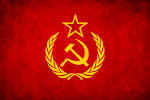
Soviet |
Soviet (chemistry) Soviet scientists L. V. Radushkevich and V. M. Lukyanovich publish images of carbon nanotubes. |
|
30 Nov 1951

autocode |
autocode (computer science) The first autocode and its compiler are developed by Alick Glennie for the Manchester Mark 1 computer, considered as the first working high-level compiled programming language. |
|
30 Nov 1951

Derek J. de Solla Price |
Derek J. de Solla Price (history of science) Discovery by Derek J. de Solla Price of a lost medieval scientific work entitled Equatorie of the Planetis, initially attributed to Geoffrey Chaucer. |
|
30 Nov 1951

John Forbes Nash, Jr. |
John Forbes Nash, Jr. (mathematics) John Forbes Nash, Jr. produces groundbreaking work in the area of real algebraic geometry. |
|
30 Nov 1951
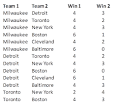
Bradley–Terry model |
Bradley–Terry model (mathematics) The Bradley–Terry model in probability theory is presented. |
|
30 Nov 1951

anesthesiologist |
anesthesiologist (medicine) American obstetrical anesthesiologist Dr. Virginia Apgar devizes the Apgar score as a simple replicable method of quickly and summarily assessing the health of babies immediately after childbirth. |
|
30 Nov 1951
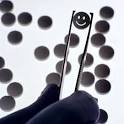
antidepressant |
antidepressant (medicine) Jean Delay, head of psychiatry at Sainte-Anne Hospital, Paris, with Jean-François Buisson, reports the antidepressant effect of isoniazid. |
|
30 Nov 1951

Geoffrey Dummer |
Geoffrey Dummer (physics) Geoffrey Dummer proposes the integrated circuit. |
|
30 Nov 1951
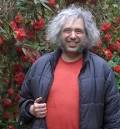
Simon P. Norton |
birth Simon P. Norton Simon P. Norton, English mathematician |
|
05 Feb 1952

Don’t Walk Signs |
Don’t Walk Signs In 1952, some sources say - apparently incorrectly - that the first time a pedestrian "Don't Walk" sign was installed in America, it was on this day, in New York City. Others cite the date as 29 Feb 1952. However, much earlier examples have been discussed in an article on the Highway History page of the U.S. Department of Transportation web site. This article has found examples of “Don't Walk” signs dating from the late 1930's. |
|
06 Feb 1952
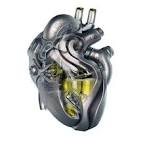
mechanical heart |
mechanical heart (medicine) A mechanical heart is used for the first time in a human patient, in the United States. |
|
01 Mar 1952
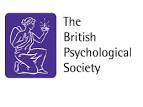
British Psychological Society |
British Psychological Society (medicine) The British Psychological Society is founded. |
|
05 Mar 1952
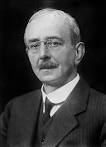
Sir Charles Sherrington |
death Sir Charles Sherrington Sir Charles Sherrington (born 1857), English neurophysiologist & bacteriologist, Nobel Prize in Physiology or Medicine 1932. |
|
10 May 1952
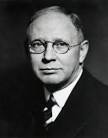
Clark L. Hull |
death Clark L. Hull Died 10 May 1952 at age 67 (born 24 May 1884). Clark Leonard Hull was an American psychologist who developed an influential theory of behaviour in which he identified the variables that intervene between stimulus and response. He made experimental studies on learning, that he presented in his book, Aptitude Testing (1928) and attempted to structure psychological theory following a deductive method of reasoning similar to that used in geometry. He proposed that from a set of postulates about psychology, logical conclusions could be deduced and tested. Hull was the first known psychologist to apply quantitative experimental methods to the investigation of hypnosis. His last books were Essentials of Behavior (1951) and A Behavior System (1952). |
|
10 Jun 1952

Mylar |
Mylar In 1952, Mylar® was registered as a DuPont trademark for an extraordinarily strong polyester film that grew out of the development of Dacron® in the early 1950s. During the 1960s its superior strength steadily replaced cellophane because of its its superior strength, heat resistance, and excellent insulating properties. The unique qualities of the film made new consumer markets in magnetic audio and video tape, capacitor dielectrics, packaging and batteries possible. By the 1970s, it become DuPont's best-selling film, despite mounting competition. It is also used as food wrap, for balloons, and by instrument manufacturers to produce high-quality drumheads. |
|
03 Jul 1952

Heart surgery |
Heart surgery In 1952, the first surgical operation in the U.S. to expose the heart's mitral valve for a prolonged time was undertaken by Dr Forest Dewey Dodrill at the Harper Hospital, Detroit, Mich. The patient, a 41-year-old man, was provided with The Michigan Heart as a substitute for the lower left ventricle. |
|
01 Aug 1952

San Benedicto rock wren |
San Benedicto rock wren (biology) Around 9 o'clock AM, the San Benedicto rock wren goes extinct as its island home is smothered in a massive volcanic eruption. |
|
14 Aug 1952
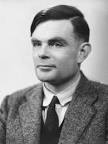
Alan Turing |
Alan Turing (biology) Alan Turing's paper "The Chemical Basis of Morphogenesis" is published, putting forward a reaction–diffusion hypothesis of pattern formation, considered a seminal piece of work in morphogenesis. |
|
28 Aug 1952

Alan Hodgkin |
Alan Hodgkin (biology) Alan Hodgkin and Andrew Huxley publish the Hodgkin–Huxley model of action potentials in neurons of the squid giant axon. |
|
02 Sep 1952

cardiac shunt |
cardiac shunt (medicine) The first successful operation to correct a cardiac shunt ("hole in the heart") is performed by Drs F. John Lewis and C. Walton Lillehei on a 5-year-old girl in the United States utilising the induced hypothermia technique developed by Wilfred Gordon "Bill" Bigelow. |
|
05 Sep 1952

Hermann Stieve |
death Hermann Stieve Hermann Stieve, German anatomist and histologist (born 1886) |
|
20 Sep 1952

DNA |
DNA In 1952, Alfred Hershey and Martha Chase published a report confirming DNA holds hereditary data. Their experiment used the T2 bacteriophage, which, like other viruses, is just a crystal of DNA and protein. It can reproduce when inside a bacterium such as E. coli. When the new T2 viruses are ready to leave the host E. coli cell (and go infect others), they burst the E. coli cell open, killing it (hence the name "bacteriophage"). Hershey and Chase were seeking an answer to the question, "Is it the viral DNA or viral protein coat (capsid) that is the viral genetic code material which gets injected into the E. coli?" Their results indicated that the viral DNA, not the protein, is its genetic code material. |
|
20 Sep 1952
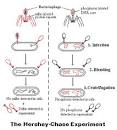
Hershey–Chase experiment |
Hershey–Chase experiment (biology) Publication of the paper on the Hershey–Chase experiment showing conclusively that DNA, not protein, is the genetic material of bacteriophages. |
|
30 Sep 1952
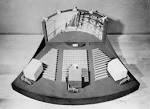
Cinerama |
Cinerama (technology) The Cinerama widescreen film system, developed by Fred Waller, debuts with the movie This Is Cinerama at the Broadway Theatre in New York City. |
|
03 Oct 1952
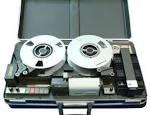
Videotape recording |
Videotape recording In 1952, the first U.S. video recording on magnetic tape giving credible results of off-air black and white recordings was made by John T. Mullin at the electronics division of Bing Crosby Enterprises, Inc., Los Angeles, Cal. Using a Video Tape Recorder, the images on magnetic tape were not only one-third less costly than photographic methods, but were also immediately available to reproduce on a standard TV monitor tube as soon as the tape was rewound. The 12-head VTR used one-inch tape running at 120 inches per second to record ten tracks of monochrome video information, a clock track to control synchronization and an FM audio track. The basic theory was to use frequency division multiplexing with the 10 channels covering the desired video range. |
|
03 Oct 1952
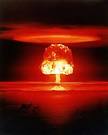
First UK atom bomb test |
First UK atom bomb test In 1952, “Hurricane,” the first British atomic bomb was tested at the Monte Bello, Australia, becoming the third country in the world to test such a weapon. The bomb used an improved plutonium implosion bomb similar to the U.S. "Fat Man". The bomb used plutonium produced in Britain at Windscale (now Sellafield) with a low Pu-240 content since hurried production led to short irradiation times, plus some Canadian origin plutonium. To test the effects of a ship-smuggled bomb (a threat of great concern at the time), Hurricane was exploded inside the hull of the HMS Plym (1450 ton frigate) which was anchored in 40 feet of water 400 yards off shore. The explosion, 9-ft below the water line, left a saucer-shaped crater on the seabed 20-ft deep and 1,000-ft across. |
|
07 Oct 1952

barcode |
barcode (technology) The barcode is patented in the United States by Norman J. Woodland and Bernard Silver, though it does not make its first appearance in an American shop until 1974. |
|
01 Nov 1952
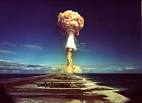
Nuclear testing |
Nuclear testing (physics) Nuclear testing: Operation Ivy – The United States successfully detonates the first hydrogen device, codenamed "Ivy Mike" ["m" for megaton], at Eniwetok island in the Bikini Atoll located in the Pacific Ocean. The elements einsteinium and fermium are discovered in the fallout. |
|
02 Nov 1952
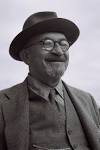
Chaim Weizmann |
death Chaim Weizmann Chaim Weizmann (born 1874), chemist, first President of Israel. |
|
20 Nov 1952
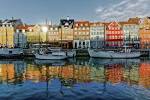
Copenhagen |
Copenhagen (medicine) The first successful sex reasignment surgery was performed in Copenhagen, making George Jorgensen Jr. become Christine Jorgensen. |
|
01 Dec 1952

Robert Gwyn Macfarlane |
Robert Gwyn Macfarlane (medicine) Robert Gwyn Macfarlane and colleagues publish the first identification of Haemophilia B. |
|
05 Dec 1952

London Great Smog |
London Great Smog In 1952, a dense smog descended on London, England, that would last four days, causing at least 4,000 deaths and chaos for transportation as visibility was reduced to a few hundred yards. Freshening winds and a rise in temperature dissipated the fog, which cleared on 9 Dec 1952. Although the London Underground could maintain service, but during the four days of smog bus service was vitually shut down when visibility was reduced so severely the roads became congested. During the time of dense fog, most flights in to London Airport were diverted to Hurn, near Bournemouth and linked by train with a Waterloo. The many deaths were of mostly among the elderly, the very young, or those with medical problems. The cause of the smog was coal-burning and required drastic action: the Clear Air Act of 1956. |
|
14 Dec 1952

conjoined twins |
conjoined twins (medicine) The first successful surgical separation of conjoined twins is conducted in Mount Sinai Hospital, Cleveland, Ohio. |
|
19 Dec 1952

Colonel Sir Charles Arden-Close |
death Colonel Sir Charles Arden-Close Colonel Sir Charles Arden-Close (born 1865), British cartographer. |
|
29 Dec 1952
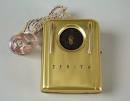
Transistor hearing aid |
Transistor hearing aid In 1952, the first transistor hearing aid went on sale, the model 1010 manufactured by the Sonotone Corporation in Elmsford, NY, U.S. It weighed 3.5-oz, measured 3"x1.5"x0.6" and cost $229.50 (about $1500.00 today). It was a hybrid device consisting of two sub miniature pre-amplifier tubes and a single transistor as the final audio amplifier to benefit from the low power consumption of transistors. The reason for the hybrid design was that the first junction transistors had signal to noise ratios which were inferior to tubes. Within months, transistor production techniques were improved largely eliminating noise, so the hybrid model was shortly discontinued. |